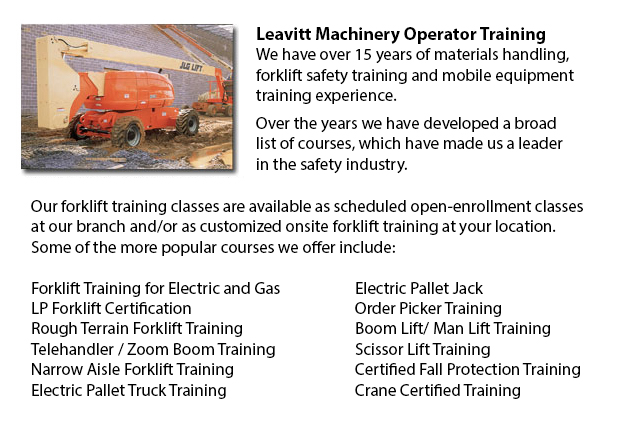
Aerial Platform Training Oakville - Aerial forklifts can be utilized to accomplish certain unique tasks done in hard to reach aerial places. A few of the duties associated with this kind of lift include performing regular maintenance on buildings with prominent ceilings, repairing phone and power cables, lifting burdensome shelving units, and pruning tree branches. A ladder might also be utilized for some of the aforementioned tasks, although aerial hoists offer more security and stability when correctly used.
There are a variety of distinctive models of aerial forklifts existing, each being capable of performing moderately unique jobs. Painters will usually use a scissor lift platform, which is able to be used to reach the 2nd story of buildings. The scissor aerial platform lifts use criss-cross braces to stretch out and extend upwards. There is a table attached to the top of the braces that rises simultaneously as the criss-cross braces raise.
Cherry pickers and bucket lift trucks are a further type of the aerial lift. Commonly, they possess a bucket at the end of an elongated arm and as the arm unfolds, the attached bucket platform rises. Platform lifts utilize a pronged arm that rises upwards as the handle is moved. Boom hoists have a hydraulic arm that extends outward and hoists the platform. All of these aerial lifts call for special training to operate.
Training courses offered through Occupational Safety & Health Association, known also as OSHA, embrace safety steps, machine operation, upkeep and inspection and machine load capacities. Successful completion of these education courses earns a special certified license. Only properly licensed individuals who have OSHA operating licenses should operate aerial lift trucks. The Occupational Safety & Health Organization has formed guidelines to uphold safety and prevent injury when using aerial lifts. Common sense rules such as not utilizing this apparatus to give rides and ensuring all tires on aerial hoists are braced so as to prevent machine tipping are observed within the rules.
Regrettably, figures illustrate that in excess of 20 operators pass away each year when running aerial lift trucks and 8% of those are commercial painters. The majority of these incidents are due to improper tire bracing and the hoist falling over; for that reason some of these deaths had been preventable. Operators should ensure that all wheels are locked and braces as a critical security precaution to stop the machine from toppling over.
Other suggestions include marking the surrounding area of the machine in an observable manner to safeguard passers-by and to ensure they do not come too close to the operating machine. It is imperative to ensure that there are also 10 feet of clearance amid any electrical lines and the aerial hoist. Operators of this equipment are also highly recommended to always wear the proper safety harness while up in the air.
-
Order Picker License Oakville
Order Picker License Oakville - Order preparation operation or order picking as it is more normally known is a method used within warehouse operations and consists of employees called order pickers. The order picker's task is to collect and take arti... More -
Forklift Operator Certification Oakville
Forklift Operator Certification Oakville - Forklift operator certification is normally needed for personnel working within industrial, warehouse or construction setting to guarantee the safe utilization of forklifts. Workplace training need to follow... More -
Scissor Lift Certification Oakville
Scissor Lift Certification Oakville - A lot of worksites and tradespeople like iron workers, welders and masons utilize scissor lift platforms to help them reach elevated work areas. The utilization of a scissor lift is usually secondary to their tra... More -
Forklift Training Courses Oakville
Forklift Training Courses Oakville - When forklift operator safety training is customized for illiteracy, training time is reduced by 50%. Train the trainer, forklift training certification and lift-truck operator driver safety training evaluation pr... More -
Manlift Training Oakville
Manlift Training Oakville - There are numerous manlift training programs which offer a review of the manlift machinery. The practicum portion of the training is one more vital portion of the course. In this section the trainee has chance to demonstra... More -
Boom Lift License Oakville
Boom Lift License Oakville - To operate an aerial boom lift, operators should be licensed through training that can be obtained utilizing both classroom sessions and practical training and by attaining a boom lift license. Instruction should be given... More -
Crane / Overhead Crane / Self-Erect Crane / Truck Mounted Crane / Hydraulic Cranes Training in Oakville
Bridge cranes or likewise called overhead cranes are actually a type of industrial material handling crane using a line and hook mechanism that runs on a horizontal beam running along two widely separated rails. Several overhead cranes could be seen... More -
Telehandler Training in Oakville
Telescopic handlers normally called telehandlers for short, are an extremely popular piece of heavy construction machinery. They are widely utilized in the construction and agricultural trades. These machines have maximum reaching ability and could g... More

Forklift Training Oakville
TOLL FREE: 1-888-254-6157
Oakville, Ontario
forklifttrainingoakville.com
Email Us
About Us


